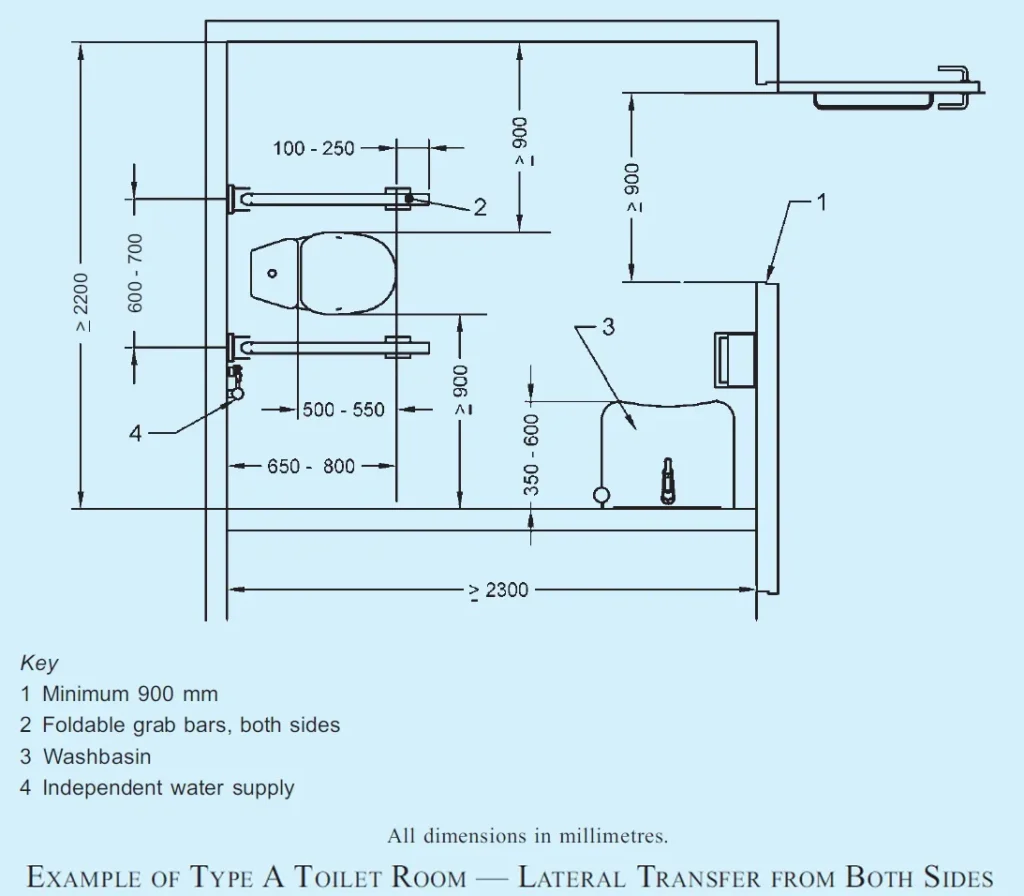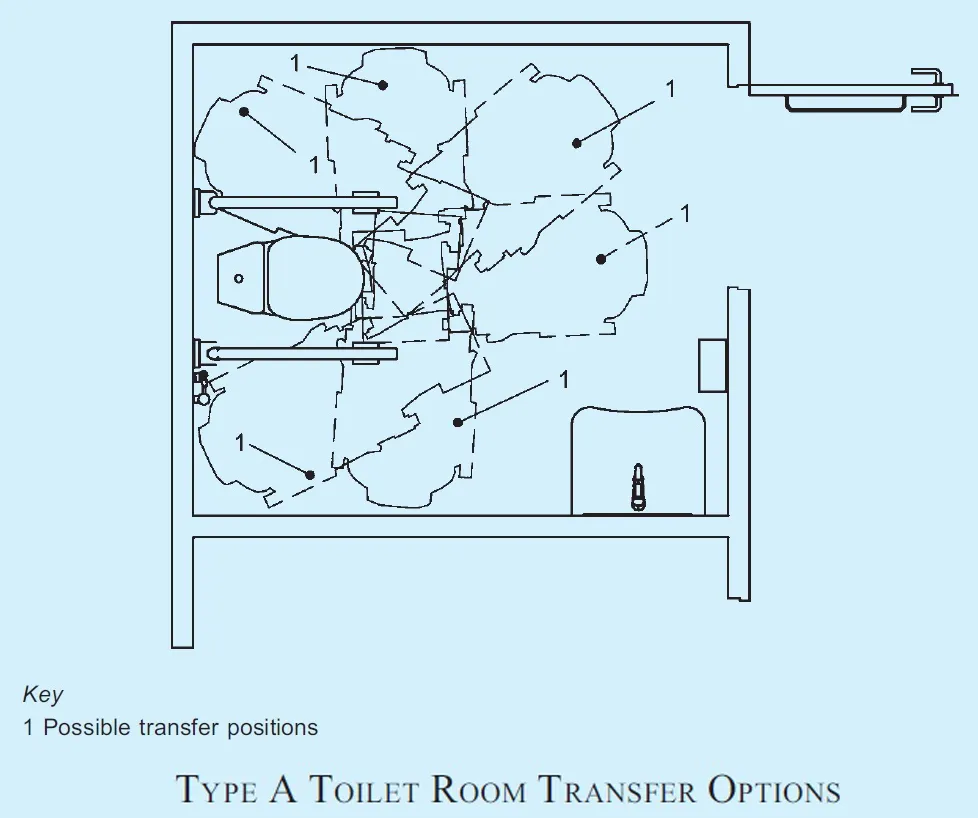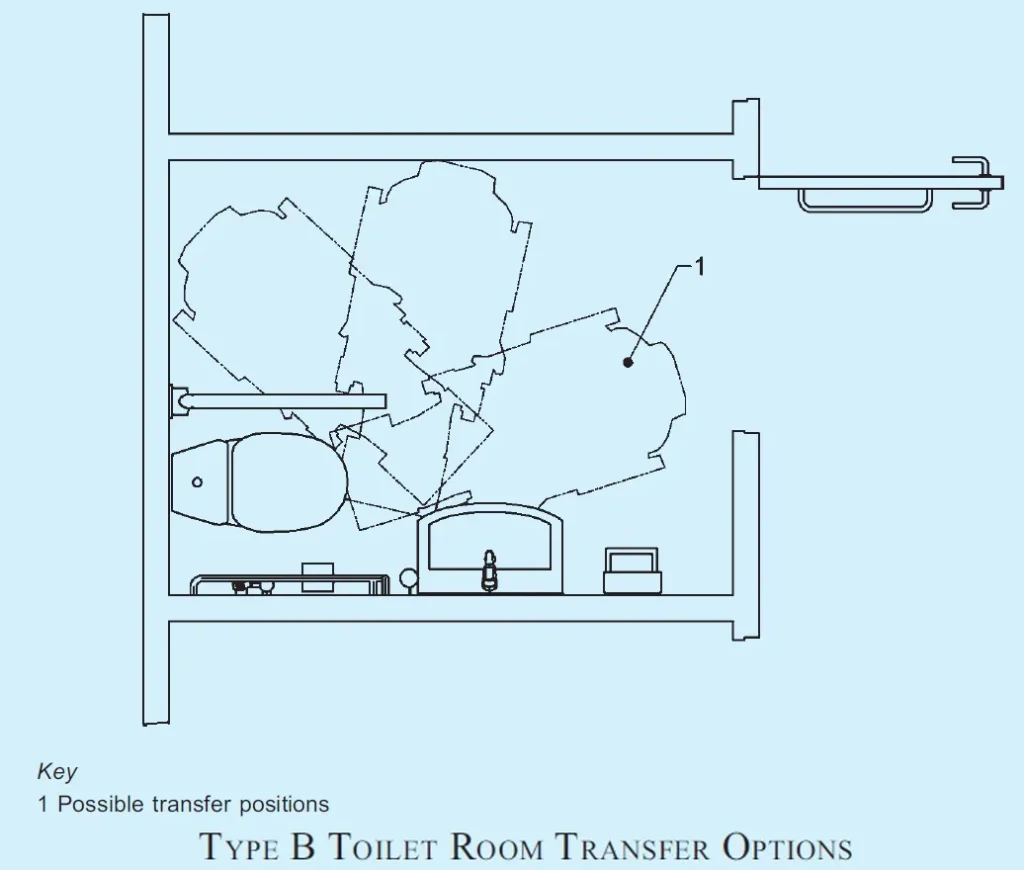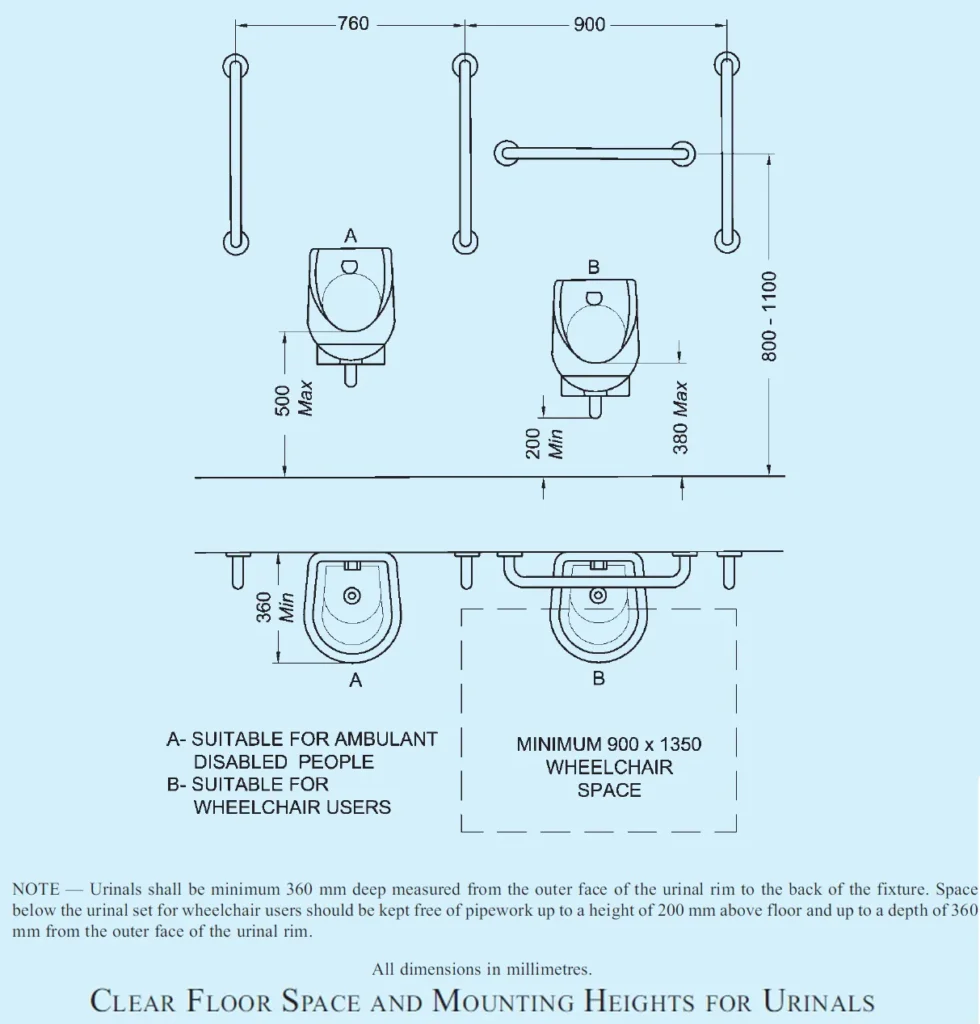If you want to know about the disabled parking space or mobility devices and space allowance for disabled person or theory of proportion, please click the link.
A wheelchair accessible toilet is a bathroom that is designed to accommodate people who use wheelchairs. There are several design considerations that can make a toilet accessible for people with disabilities.
- People using a wheelchair typically require more space to move, making specially designed accessible toilets necessary.
- This article gives the characteristics and requirements for the two types of wheelchair user accessible toilet rooms, namely, Type A and Type B.
- The clear manoeuvring space of the toilet room shall allow frontal, oblique and lateral transfer. Type A toilet with a central placement of WC allows right and left lateral transfer, and may be more suitable when assistance is needed. Types B only allow one side transfer.
- The clear manoeuvring space at floor level in front of the water-closet and the washbasin in case of Type A toilets shall be 1800 mm × 1800 mm, except for Type B where it shall be 1500 mm × 1500 mm by using the 300 mm space under the washbasin as part of the total manoeuvring space.
- The minimum free clearance beside the water-closet shall be 900 mm, whereas 1200 mm is preferred for lateral transfer and assistance.
Note – Minimum clearance of 900mm accommodates only 65% of the wheelchair users, clearance of 1200 mm. accommodates 90% of all wheelchair users especially also those who use powered wheelchairs.
- The minimum dimensions for a Type A accessible toilet room are 2200 mm width and 2300 mm depth, and the minimum dimensions for a Type B accessible toilet room are 1700 mm width and 2200 mm depth.
Note – In case of existing buildings, as part of exceptional considerations, the measures given above cannot be achieved due to technical reasons, the manoeuvring space at floor level may be reduced, but it should be recognized that such a reduction limits the number of people who can use these toilet rooms.
1) Type A Toilet Room design
Type A Toilet Room with Lateral Transfer from Both Sides.
i) Characteristics of Type A accessible toilet room design


- Lateral transfer from both sides,
- Manoeuvring space uninterrupted by washbasin and pan,
- Independent water supply beside water-closet,
- Horizontal grab rails at both sides, and
- Toilet paper dispensers on both folding grab rails.
ii) Requirements of Type A accessible toilet room design
- It shall have minimum internal dimensions 2200 mm × 2300 mm.
- The layout of the fixtures in the toilet shall be such that there is a clear manoeuvring space that provides a wheelchair turning radius of 1800 mm in front of the water-closet and washbasin in the accessible toilet unit.
- It shall have all fixtures and utilities arranged in a manner to provide a clear space of 900mm × 1350mm for wheelchair users to access them.
- It shall have clear space of not less than 900 mm wide next to the water-closet.
- It shall be equipped with a door complying with Toilet or Sanitary Room Doors (given below).
- It shall have a water-closet complying with Water-Closet, grab bars complying with Grab Bars and washbasin complying with Washbasin (given below).
- It shall have essential washroom accessories complying with Other Toilet Accessories and Fittings (given below).
- It shall have an alarm to seek emergency help, complying with Alarm (given below).
- It shall have the toilet roll dispenser and hand water faucet mounted below the grab bars and at not more than 300 mm from the front edge of the seat and at a height between 50 mm and 200 mm from the top of the water-closet seat.
- Cloth hooks should be set at different heights, 900 mm to 1100 mm, and additionally at least one hook at 1400 mm; and projecting not more than 40 mm from the wall.
- Where possible, be equipped with a shelf of dimensions 400 mm × 200 mm fixed at a height of between 900 mm and 1000 mm from the floor.
2) Type B Toilet Room design
Type B Toilet Room with Lateral Transfer from One Side Only
i) Characteristics of Type B accessible toilet room design


- Lateral transfer only from one side;
- Manoeuvring space reduced by washbasin;
- Independent water supply beside water-closet, with floor drain where necessary;
- Ability to reach small wash hand basin when seated on toilet;
- Horizontal grab rail on wall beside the water-closet;
- Vertical grab rail on wall beside the water-closet for getting up and sitting down (slanted grab bars are not preferred);
- Foldable grab rail; and
- Toilet paper dispenser fixed on the wall beside the water-closet.
ii) Requirements of Type B accessible toilet room design
- It shall have minimum internal dimensions of 1700 mm × 2200 mm.
- It shall have all fixtures and utilities arranged in a manner to provide a clear space of 900 mm × 1350 mm for wheelchair users to access them.
- It shall have clear space of not less than 900 mm wide next to the water-closet.
- It shall be equipped with a door complying with Toilet or Sanitary Room Doors (given below).
- It shall have a water-closet complying with Water-Closet, grab bars complying with Grab Bars and washbasin complying with Washbasin (given below).
- It shall have essential washroom accessories complying with Other Toilet Accessories and Fittings (given below).
- It shall have an alarm to seek emergency help, complying with Alarm (given below).
- It shall have the toilet roll dispenser and hand water faucet mounted below the grab bars and at not more than 300 mm from the front edge of the seat and at a height between 50 mm and 200 mm from the top of the water-closet seat.
- Cloth hooks should be set at different heights, 900 mm to 1100 mm, and additionally at least one hook at 1400 mm; and projecting not more than 40 mm from the wall.
- Where possible, be equipped with a shelf of dimensions 400 mm × 200 mm fixed at a height of between 900 mm and 1000 mm from the floor.
3) accessible toilet room design complying with…
i) Toilet or Sanitary Room Doors
- The toilet door shall either be an outward opening door or two-way opening door or a sliding type and shall provide an unobstructed and clear opening width of at least 900 mm; it shall be easy to open and close.
- There should be no openings under or above the door that compromises on privacy.
- Doors should be positioned so as not to constitute a hazard.
- The toilet door shall be provided with a horizontal pull-bar, at least 600 mm long, on the inside of the door, located so that it is 130 mm from the hinged side of the door and at a height of 900 mm to 1000 mm.
- A horizontal pull handle on the inside of the outward opening doors shall be provided at a height of 700 mm above the floor.
- The door shall be capable of being locked from the inside by a device that is operable by one hand, activated by a force not more than 22 N and which does not require fine finger control, tight grasping, pinching or twisting of the wrist.
ii) Water-Closet
Water-closet shall comply with the following requirements
- It shall be so located that the distance between centerline of the water-closet to the adjacent wall in case of corner toilets (Type B) be between 450 mm and 480 mm. The minimum distance of a corner toilet from the edge of the WC seat to the adjacent wall should be 250 mm. In case of Type A toilet, the distance from the edge of the WC seat to the adjacent wall shall be 900 mm, minimum on both sides to allow ease of transfer.
- The top of the water-closet shall be between 450 mm and 480 mm from the floor.
- The minimum distance from the front edge of the water-closet to the rear wall should be between 650 mm and 800 mm.
- There shall be an adequate clear floor space of at least 1300 mm depth and 900 mm width, both in front and on the transfer side, adjacent to the water-closet.
- There shall be a suitable back support to reduce the chance of imbalance or injury caused by leaning against exposed valves or pipes. The distance from the seat to the backrest should range between 500 mm and 550 mm.
- The water-closet shall preferably be of wall- hung or corbel type as it provides additional space at the toe level.
- Where water cistern is used, the cover shall be securely attached, and the flush control shall either be lever type or automatic and located on the transfer side of the water-closet. The flush control shall not be located more than 1000 mm from the floor.
- Toilets for children should have a distance from the centre line to the adjacent wall between 305 mm and 380 mm and the water-closet height shall be between 205 mm and 380 mm.
iii) Grab Bars
- On both sides of a toilet, a grab bar (whether drop-down or fixed to the wall) shall be provided at a distance between 300 mm and 350 mm from the centre line of the toilet.
- On the sides where a lateral transfer is possible, a foldable grab bar (drop-down support bar) shall be provided at a height of 200 mm to 300 mm above the water-closet.
- The length of the foldable grab bar should overlap the front edge of the water-closet in between 100 mm and 250 mm.
- The positioning of a foldable grab bar should allow access from a wheelchair when folded up.
- Where a wall is beside the toilet, a horizontal grab bar shall be provided at a height of 200 mm to 300 mm above the water-closet, and a vertical grab bar shall exceed from the horizontal grab bar to a height of 1500-1700 mm above floor level.
- The grab bar shall extend a distance of minimum 150 mm to the front edge of the water-closet.
- Alternatively, one L-shape grab bar, 600 mm long horizontal and 700-900 mm long vertical shall be mounted on the side wall closest to the water-closet, as illustrated in Figure below.

- The horizontal grab bar shall be uninterrupted for its full length.
- The positioning of accessories such as hand towel, soap, waste bin, etc., should not hamper the use of the grab bar.
- The grab bar height for toilets for children should be between 510 mm and 635 mm.
iv) Washbasin
A washbasin complying with following requirements shall be provided within an accessible toilet room as shown in this figure below.

- The positioning of a washbasin should allow access from a wheelchair. It shall provide a minimum clear floor space of 900 mm wide by 1200 mm deep, of which a maximum of 480 mm in depth may be under the washbasin.
- It shall be mounted such that the minimum distance between the centreline of the fixture and the side wall is 460 mm; and the top edge of the washbasin is between 750 mm and 850 mm from the floor.
- The differences in stature may require lower or higher heights of washbasins and it may be advisable to have an inbuilt flexibility to increase or decrease height.
- The space under the washbasin shall be unobstructed with a knee clearance centred on the washbasin between 680 mm and 700 mm high, and 200 mm deep. In addition, a toe clearance of at least 300 mm high shall be provided as shown in this figure below.

- The front edge of the washbasin shall be located within a distance of 350 mm to 600 mm from the wall, according to Figure below shown.

- The hot water and drain pipes within the knee space or toe space shall be properly insulated.
- Automatic or lever type faucets/taps shall be provided complying with Taps (given below).
- In front of the washbasin, space should allow for a frontal or oblique approach by a wheelchair. The reaching distance to the tap control shall be a maximum of 300 mm, according to Figure below.

- Edges on washbasins should be rounded.
- The mirror above the washbasin shall be positioned to have the bottom edge at a height of not more than 900 mm above the floor, up to a height of 1900 mm as shown in this figure below.

- If a second mirror is provided, the maximum height above the floor should be 600 mm, up to 1850 mm. The mirror shall be tilted at an angle of 30° for better visibility of wheelchair user. Care shall be taken in placing mirrors and lights to avoid confusion and dazzling for visually impaired users.
- A shelf with minimum dimensions of 200mm × 400mm should be provided near the washbasin at a height of 850mm or combined with the washbasin.
v) Other Toilet Accessories and Fittings
- All other fittings, for example the water tank, hand dryer, towel, soap dispensers, waste bins, hand-held shower, etc., should be set at a height between 800mm and 1100mm from the floor as shown in this figure below.

- Coat hooks should be set at different heights, 900mm to 1100mm, and additionally at least one hook at 1400 mm.
- Accessories shall be placed in close proximity to the basin, to avoid a person with wet hands wheeling a chair.
- Dispensers for toilet paper shall be reachable from the water-closet, either under the grab bar or on the side- wall of a corner toilet at a height between 600 mm and 700 mm from the floor as shown in this figure above.
- Light switches should be fixed inside all accessible toilet cubicles, or the lighting should automatically switch on when someone enters the room. Timed light switches should not be installed or used.
- Needle boxes to safely dispose of needles (for example from diabetes patients) should be provided.
- If a sanitary bin is supplied, it should be reachable from the water-closet. Sanitary bins with non-touch opening devices are preferred.
- Non-touch soap dispensers are preferred.
vi) Taps
- The tap controls should be set no more than 300 mm from the front of the washbasin.
- It is recommended that a thermostat be installed to limit the temperature of the hot water to a maximum of 40°C in order to prevent scalding.
- Hot and cold water taps should be identifiable by both colour and tactile markings.
vii) Urinals
- Wheelchair users may be able to pull themselves to a standing position to use a urinal, or they may be able to use a urinal from their wheelchair.
- Ambulant persons with disabilities, for example crutch users, may need support in front of urinals. Bowl urinals are preferable to slab urinals for the benefit of visually impaired.
- When wall hung urinals are fitted in the washroom, it is recommended that at least one of these have its rim set at a height of 380 mm for wheelchair users and at least one have its rim set at a height of 500 mm for standing users/ambulant disabled.
- When installed, both should be equipped with a vertical grab rail.
- Urinals shall be minimum 360mm deep measured from the outer face of the urinal rim to the back of the fixture.
- The lower urinal position as shown in Figure below is also beneficial to a person of lower stature.

- Where an accessible urinal is provided, the accessible approach to the same shall be ensured.
- This wall hung urinal should be set clear above the floor level, without any raised access platform and with a clear floor area in front of the urinal of at least 760mm wide and 1220 mm deep to allow forward approach for ambulant disabled and minimum of 900 mm × 1350 mm for wheelchair users to use the urinals as shown in this figure below.

- Urinals should contrast visually with the wall to which they are attached.
ix) Alarm
- An assistance alarm, which can be reached from changing or shower seats, from the WC and by a person lying on the floor, shall be provided in all accessible toilets and accessible sanitary rooms.
- This alarm should be connected to an emergency help point, or where a member of staff can assist.
- Visual and audible feedback should be provided to indicate that, when the alarm has been operated, the emergency assistance call has been acknowledged and action has been taken.
- It should take the form of a pull cord, coloured red, with two red bangles of 50 mm diameter, one set at a height between 800mm and 1100mm and the other set at 100mm above floor level.
- A reset control shall be provided for use if the alarm is activated by mistake.
- It shall be reachable from a wheelchair and, where relevant, from the WC, the tip- up seat in a shower or changing facility, or the bed in an accessible bedroom.
- The reset control shall be easy to operate and located with its bottom edge between 800mm and 1100mm above floor level.
- For a corner toilet room, the reset button should be above the fixed horizontal grab rail beside the toilet paper holder.
- The marking of the reset control shall be both visible and tactile.
x) Emergency Warning Alarm
- A visual emergency alarm shall be provided to alert people who are deaf or hard of hearing in the event of an emergency.
By taking these design considerations into account, architects and designers can create toilet facilities that are accessible and usable for people with disabilities.